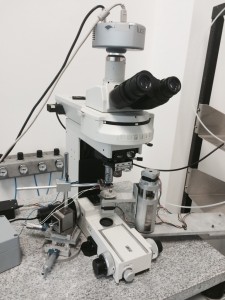 Nikon Instruments
Nikon Instruments
Marco Monticelli, Dario Valter Conca, Daniela Petti
NaBiS group and collaborators
Nanomagnetism Lab – via G. Colombo 81, 20133 Milano (Italy)
Description:
Nikon Eclipse FN1 is an optical microscope equipped with two objectives (4x, 60x). The light is provided to the microscope by an arc-discharge mercury lamp (NIKON intensilight C-HGFI). The microscope is equipped by an electronic controller of the objectives displacements along the direction perpendicular to the focal plane, which gives the possibility to automatically acquire z-stack images. A double band excitation and emission FITC-TRITC filter combination is also mounted on the microscope allowing two channels fluorescence imaging. This filter set is designed for optimal detection of the traditional fluorescein isothiocyanate (FITC) and etramethylrhodamine isothiocyanate (TRITC) probes in combination, as well as other fluorophores with similar absorption and emission spectra. The dual excitation interference filter incorporates an excitation filter with narrow passband windows in the blue (475 to 490 nanometers) and the green (540 to 565 nanometers) spectral regions. Dual emission (barrier) filter bandpass regions enable detection of green and orange-red emission from the two fluorochromes simultaneously. Sharp transitions between transmission and reflection bands of each filter, and application of a dichromatic mirror having two bandpass transmission regions (polychromatic) chosen to be complementary to the emission and excitation wavelengths, permit dual-band signal detection with minimal interference.
Double channel fluorescence imaging has been employed in biological experiments to distinguish magnetic nanoparticles and strained cells, as well as to distinguish between different subcelluar compartments.
Data acquisition is performed by a fast electron-multiplying charge-coupled device (EM-CCD) camera (ANDOR Luca-S, Belfast UK) which has a resolution 658 x 496 pixel, max 50 fps. It is Peltier cooled down to -20°C in order to reduce the thermal electronic noise in long exposure acquisitions.
A four poles electromagnet and a system of rotating permanent magnets allow the application of a controlled, both in direction and intensity, external field on the sample during the optical observation.
Further information
For more details, please visit the manufacturer webpage.